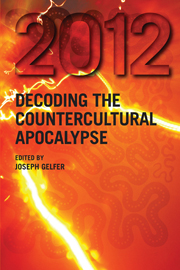Book contents
- Frontmatter
- Contents
- Contributors
- Preface
- 1 Introduction
- 2 The 2012 Phenomenon: New Uses for an Ancient Maya Calendar
- 3 Maya Prophecies, 2012 and the Problematic Nature of Truth
- 4 Mayanism Comes of (New) Age
- 5 The 2012 Milieu? Hybridity, Diversity and Stigmatised Knowledge
- 6 Chichén Itzá and Chicken Little: How Pseudosciences Embraced 2012
- 7 Roland Emmerich's 2012: A Simple Truth
- 8 The 2012 Movement, Visionary Arts and Psytrance Culture
- 9 In a Prophetic Voice: Australasia 2012
- 10 Approaching 2012: Modern Misconceptions versus Reconstructing Ancient Maya Perspectives
- Notes
- Index
8 - The 2012 Movement, Visionary Arts and Psytrance Culture
- Frontmatter
- Contents
- Contributors
- Preface
- 1 Introduction
- 2 The 2012 Phenomenon: New Uses for an Ancient Maya Calendar
- 3 Maya Prophecies, 2012 and the Problematic Nature of Truth
- 4 Mayanism Comes of (New) Age
- 5 The 2012 Milieu? Hybridity, Diversity and Stigmatised Knowledge
- 6 Chichén Itzá and Chicken Little: How Pseudosciences Embraced 2012
- 7 Roland Emmerich's 2012: A Simple Truth
- 8 The 2012 Movement, Visionary Arts and Psytrance Culture
- 9 In a Prophetic Voice: Australasia 2012
- 10 Approaching 2012: Modern Misconceptions versus Reconstructing Ancient Maya Perspectives
- Notes
- Index
Summary
With its cover featuring a Maya pyramid running an electrical current from its apex, the liner notes on the album Resolution of Duality (2004) state that the partnership Sirius Isness (Max Peterson and Davina Elmosnino)are on a “mission to help this world unite both opposing forces, good and evil, yin and yang, male and female, in order to facilitate their transmutation into unity,” and that the album “was specially created in love & peace, in the mountains of Tepoztlan, Mexico, a center of energy of the Maya civilization, where it is believed the star children will meet for ascension in the year 2012.” Themselves descended from Sirius, and having “detected an imbalance of duality between humans,” “soul mates” Sirius Isness identify as such “star children.” And they are not alone within psytrance (psychedelic trance), where the ancient Maya calendar, the Tzolk'in, and interpretations of Maya culture and art more broadly, have held considerable appeal. Such appeal manifests in collusion with a spectrum of beliefs and practices, incorporating 2012, aliens, crystal skulls, brain waves, fifth dimensionality, and cosmic ascensionism, whereby creative appropriations provide sometimes innovative and other times wild speculations. Take, for instance, Mexican artist Daniel Gradilla (aka Blue Lunar Monkey) who has released the albums 2012 (2007) and Beyond 2012 (2008).
- Type
- Chapter
- Information
- 2012Decoding the Countercultural Apocalypse, pp. 123 - 143Publisher: Acumen PublishingPrint publication year: 2012



